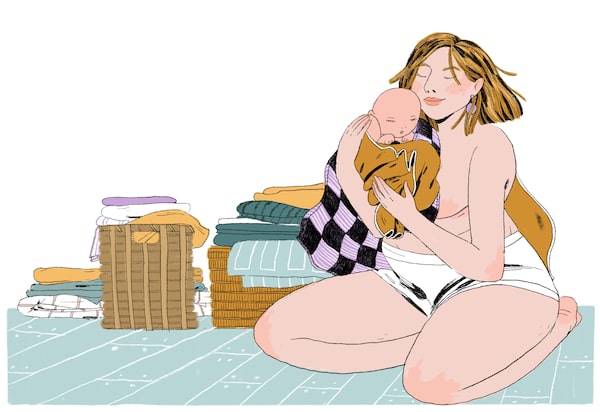First Person is a daily personal piece submitted by readers. Have a story to tell? See our guidelines at tgam.ca/essayguide.

Illustration by April Dela Noche Milne
Five days after my daughter was born, my doula came back to my home for a postpartum visit. Since she is also a photographer, I asked her to bring along her camera. “I want some photos of us both naked, together,” I said. “I had a feeling you’d ask,” she replied.
As a new family, we felt the pull toward my daughter’s ethereality, it was as if she had just stepped through a portal and we wanted to freeze in photographs the moments that we knew were about to slip behind the veil of time. It’s likely thousands of photographs were taken. She was, after all, new. As we made video phone calls and lined up visitors to introduce her to the world, I told the story of her home birth over and over again: I was recounting for visitors, but also for myself, the hilarity of the moment my water broke, how I walked myself through the intensity of bringing her into the world, how I found in the midst of those hours in the middle of the night a way to say yes to the instinctual, animal wisdom of my body, and how through it all I met myself. As the days wore on, it was becoming increasingly clear that I had just come through a portal, too. I was new, too.
As a psychologist, most of my academic research has focused on women’s relationships with their bodies, their embodiment and how women experience this across their life. I have asked women at various stages and shapes of life, of body, including postpartum, to tell me their stories. Research interviews from patients in my clinical practice have confirmed what feminist writers and academics have been saying for decades: mothers’ bodies, venerated while pregnant, become socially discarded when postpartum. Because we are our bodies, and how we judge and feel in our bodies is shaped by the social context we exist within. The visual absence of a new mother’s body in our culture notes something about our cultural values, about what it means to be a woman, a mother.
The invisibility of the postpartum body indicates a harmful social narrative: A woman’s body is valued when it is being used by or good for someone else. Then, it must disappear, only to re-emerge when no signs of motherhood, aging, expansion or change appear. It may reappear only when it can be objectified again. Mothers often take this on as if it is their own script and work tirelessly to get their “bodies back.” They often feel tremendous shame or anxiety if they cannot do so, but there is, of course, no getting back a body that does not exist any more.
While I was aware of this phenomenon from an academic and clinical standpoint, it became personally poignant when I experienced my own matresence. My body, with droopy scarred skin and still distended belly, fluid indiscriminately leaking from most orifices most of the day, was proof. But I refused to let my body be erased, made invisible, when it was the autobiography of my changing self, the record of my own beginning as a mother.
I knew I wanted images of my body in its changing glory to remind myself exactly of how I felt, of who I had become and was becoming. I felt tender and strong, fierce and fragile, empty and full, capable of any wild thing nature does and at once incapable of anything more than the most minute act of care. I did not want to lose any detail of it.
My doula/photographer noted, with delight, how unusual it was that I did not want to rearrange fabric or props to hide myself, or position the baby to distract from my soft protruding belly or large postpartum underwear. “Make sure you can see how large my areola are,” I smirked as I perfectly positioned my daughter between each breast.
I did not know at the time how important these photos would become for me as I felt my former life fracture. As sleeplessness accumulated, I looked at the photos and remembered what I knew to be true: I can be tender and strong, I can be fierce and fragile, I can be empty and full. I am capable of making and sustaining life, and also not capable of doing the laundry, or remembering the words to books I’ve written.
A woman’s body is always valuable, even when not good for someone else’s pleasure or survival. Our bodies deserve to be celebrated simply because they exist, and cherished in every stage.
The photos now rest on my bedside table, a lighthouse to the person who was brand new and wise enough to stand in defiance of a cultural script that was asking me to disappear.
Hillary McBride lives in Victoria.